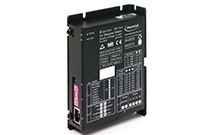- Keyboard Navigation
- Monochrome color
- Reverse color
- Accessible font
- AAA
- Cancel accessibility
Motor Driver
Motor Driver, or amplifiers, are an essential part of a motion control system, and are responsible for linking between Motion Vontrollers/PLC's to the driven unis. Specifically, drivers amplify low level digital or analog signals to high level energy in the form of voltage and current necessary for driving motors.
In motion control systems, the motion controller computes the operation requirements and motion trajectories, and sends appropriate signals to the driver which then translates these signals into proportional voltages and currents required to accelerate or decelerate the motors whilst taking the load into consideration.
Motor Driver and Motion Comtrols
The controller or PLC can be imagined as the "brain" of the system, while the driver is the "muscle" which translates the signal into physical electric power. The driver industry includes various technologies used to drive DC brush and brushless motors, AC Servo Motor, as well as step motors.
There are two main types of servo-amplifiers: linear amplifiers, and switching amplifiers. Linear amplifiers or characterized with having a constant transfer function, and therefore amplify the input signals in a linear manner.
Switching amplifiers in the motion industry rely mainly on the method of PWM (Pulse Width Modulation). PWM takes advantage of the relatively slow mechanical response time of the motor driver, and with great sophistication help in significantly reducing heat dissipation, as well as increasing the overall efficiency of the system. Specifically, the voltage is switched back and forth between two constant values (high and low), in a high frequency pulse manner.
While simple brush type motors which only require direct current to rotate, step-motors on the other hand must use a driver to rotate. To drive a Step Motor, the driver needs to be able to send a signal pulse train, which is then translated by the motor driver into physical rotational steps.
Perform Complex Positioning Tasks
This described method is known as Pulse & Direction, and is commonly used with all stepper systems. Pulse & Direction uses two pulse channels where one indicates the rotation direction, while the other gives a pulse indication for each motor step.
In today's world of motion, the boundary between servo amplifiers and Motion Control has somewhat faded. Today's digital drivers are able to perform complex positioning tasks by closing the loop with encoder signals, resolver signals, and other feedback technologies.
Analog drivers are also able to work in various unique operational settings.


